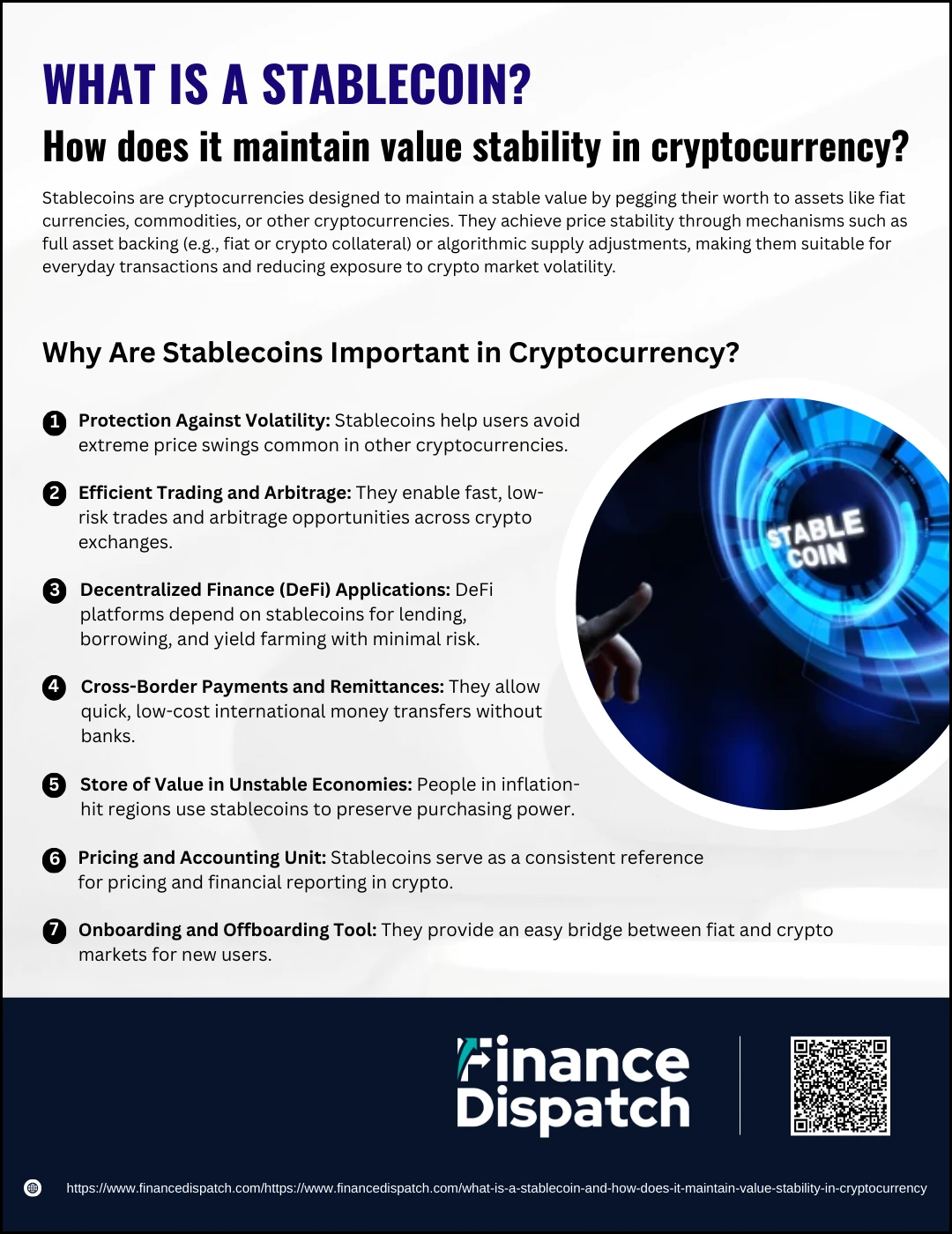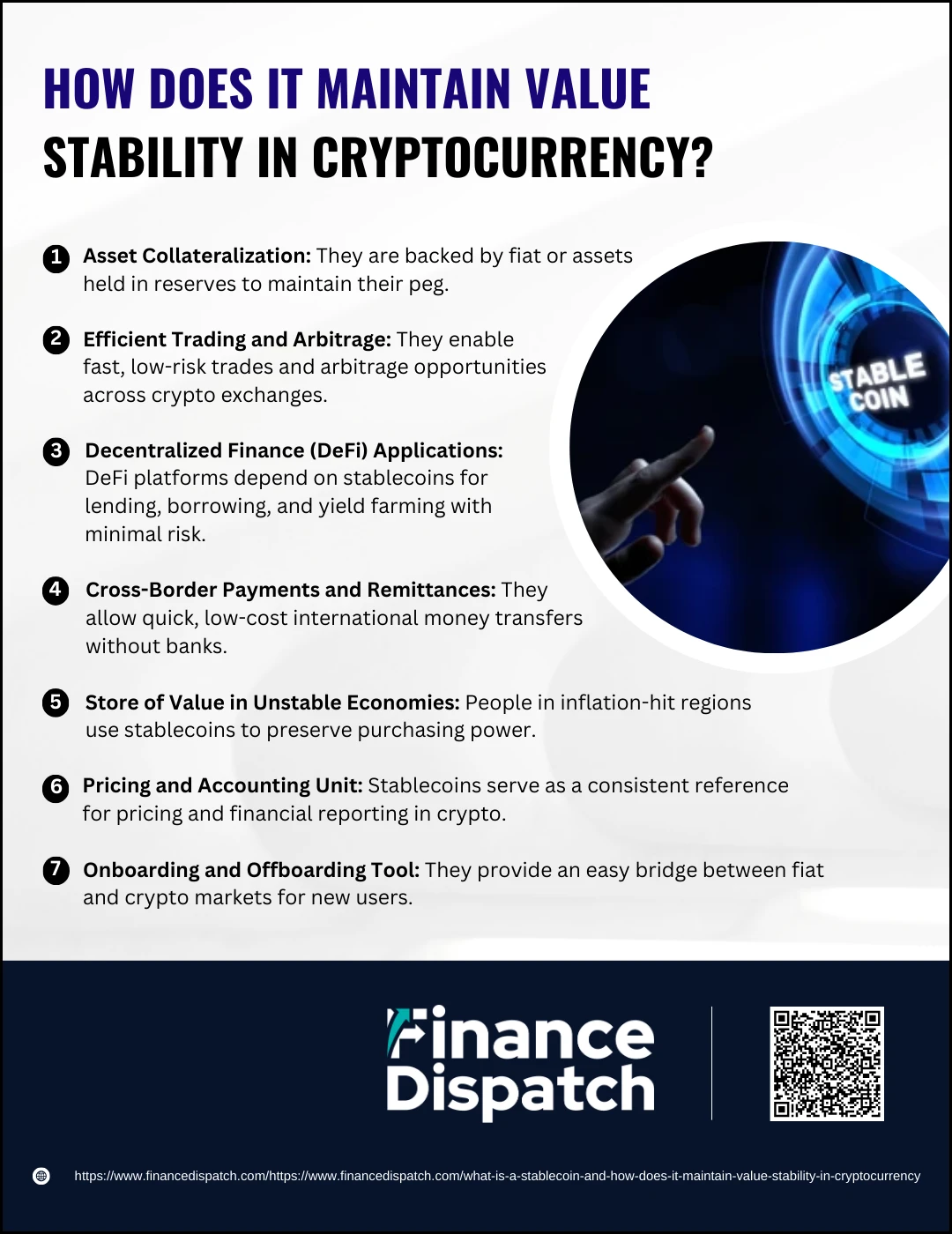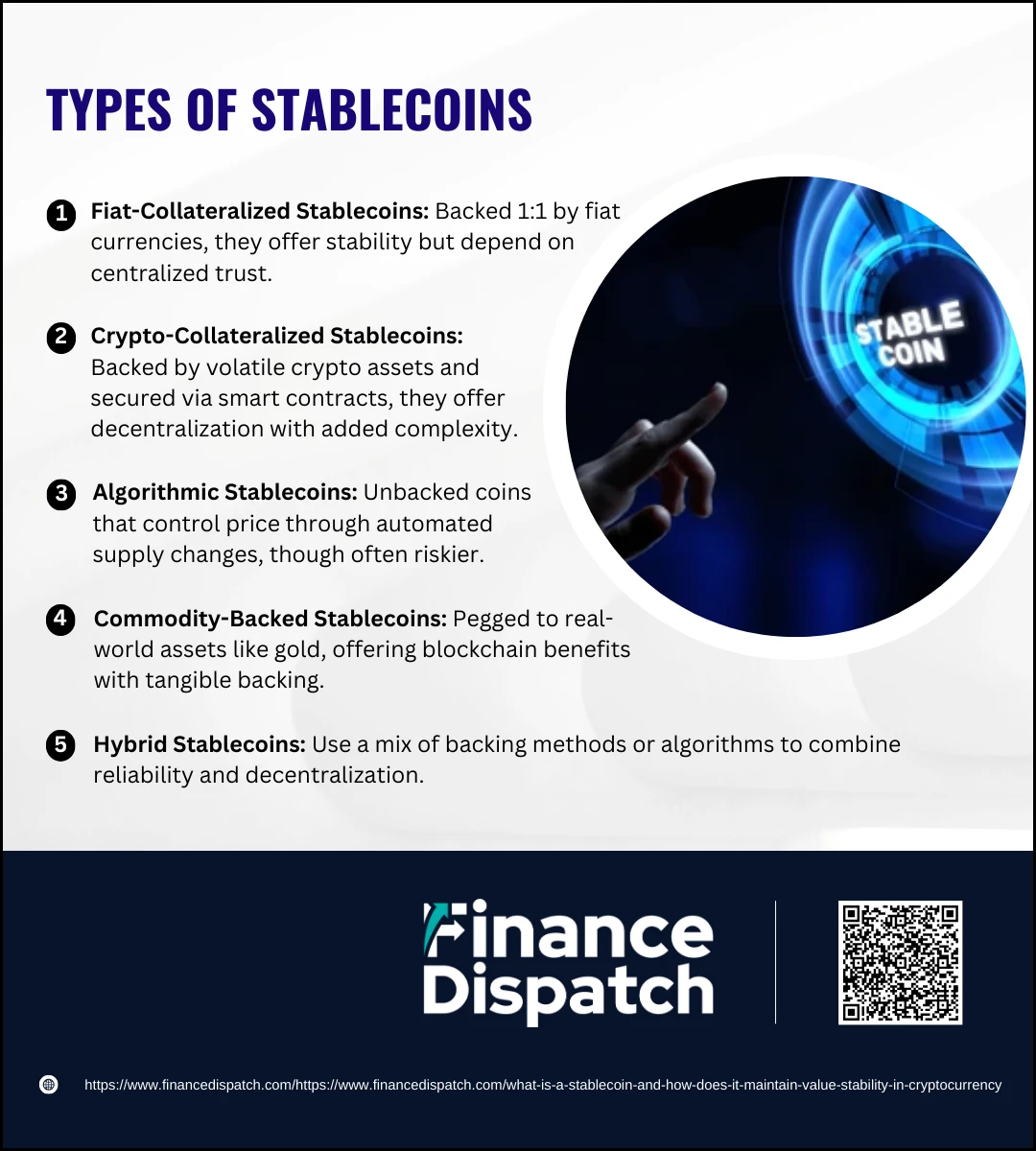In the ever-evolving world of cryptocurrency, one persistent challenge has been price volatility—a feature that makes digital assets like Bitcoin and Ethereum unpredictable for everyday use. Stablecoins were introduced as a solution to this problem, offering the stability of traditional fiat currencies while retaining the benefits of blockchain technology. These digital assets are designed to maintain a fixed value by being pegged to stable assets such as the US dollar, gold, or other reserves. As a result, stablecoins serve as a vital bridge between the traditional financial system and the decentralized world of crypto, enabling more secure transactions, greater user confidence, and broader adoption. This article explores what stablecoins are and how they maintain value stability in the cryptocurrency ecosystem.
What is a Stablecoin?
A stablecoin is a type of cryptocurrency specifically designed to maintain a consistent value over time, unlike traditional cryptocurrencies that are known for their price volatility. The value of a stablecoin is typically pegged to a stable asset such as a fiat currency (like the US dollar or euro), a commodity (such as gold), or maintained through algorithmic mechanisms. This pegging ensures that one unit of a stablecoin generally equals one unit of the underlying asset, making it a more reliable medium of exchange, store of value, and unit of account. By combining the stability of traditional financial assets with the speed, security, and transparency of blockchain technology, stablecoins have become essential tools for everyday transactions, trading, and financial applications within the crypto ecosystem.
 Why Are Stablecoins Important in Cryptocurrency?
Why Are Stablecoins Important in Cryptocurrency?
Stablecoins have become a cornerstone of the cryptocurrency ecosystem by addressing one of its biggest challenges—volatility. Traditional cryptocurrencies like Bitcoin and Ethereum can experience rapid price swings, making them less suitable for everyday use. Stablecoins solve this problem by maintaining a consistent value, usually pegged to stable assets like fiat currencies or commodities. This stability not only makes them more practical for transactions but also encourages wider adoption of crypto technologies by both individuals and institutions. As a result, stablecoins play a pivotal role in enhancing the functionality, reliability, and usability of digital finance.
Here are several reasons why stablecoins are important in cryptocurrency:
1. Protection Against Volatility
Stablecoins shield users from the wild price fluctuations seen in most cryptocurrencies, offering a safe way to hold value without exiting the crypto ecosystem.
2. Efficient Trading and Arbitrage
On both centralized and decentralized exchanges, traders rely on stablecoins to quickly move funds, hedge against price drops, and take advantage of market inefficiencies through arbitrage.
3. Decentralized Finance (DeFi) Applications
Many DeFi platforms operate on stablecoins for lending, borrowing, and yield generation. Their price stability ensures predictable returns and reduces the risk of liquidation due to market swings.
4. Cross-Border Payments and Remittances
Stablecoins enable fast, low-cost international money transfers, bypassing traditional banking systems that are slow, expensive, and often limited by geographic or political barriers.
5. Store of Value in Unstable Economies
In countries facing inflation or currency devaluation, stablecoins offer an accessible and stable alternative for preserving purchasing power and facilitating digital commerce.
6. Pricing and Accounting Unit
They act as a benchmark for pricing other cryptocurrencies and are used in financial reporting and smart contracts, thanks to their stable value.
7. Onboarding and Offboarding Tool
Stablecoins make it easier for users to enter and exit the crypto market, acting as a reliable medium between fiat and crypto. This improves accessibility and encourages adoption among mainstream users.
 How Does It Maintain Value Stability in Cryptocurrency?
How Does It Maintain Value Stability in Cryptocurrency?
Stablecoins are engineered to provide price stability in the highly volatile cryptocurrency market. Their core value proposition lies in being able to hold a steady price—most commonly $1—regardless of the ups and downs experienced by other digital currencies. This consistency makes stablecoins ideal for use in trading, savings, payments, and decentralized finance (DeFi). But maintaining that stable value isn’t automatic. It requires carefully designed mechanisms involving collateral, algorithms, market incentives, and transparency to ensure the price stays close to its intended peg.
Here are the primary ways stablecoins maintain their value stability:
1. Asset Collateralization
Many stablecoins are backed by real-world assets, such as fiat currencies held in bank reserves. For instance, a fiat-backed stablecoin like USDC holds one US dollar in reserve for every coin issued. This one-to-one backing ensures that each stablecoin can be redeemed for its underlying asset, maintaining confidence and price stability.
2. Over-Collateralization (for Crypto-Backed Coins)
Crypto-collateralized stablecoins, like DAI, are supported by other cryptocurrencies that are locked in smart contracts. Because cryptocurrencies are volatile, these stablecoins are over-collateralized—meaning the value of the locked crypto exceeds the value of the stablecoins issued (e.g., $150 in ETH collateral for every $100 in DAI). This cushion helps absorb market fluctuations and protects the peg.
3. Algorithmic Supply Control
Algorithmic stablecoins don’t rely on collateral. Instead, they use computer algorithms and smart contracts to regulate supply. When demand pushes the price above the peg, new coins are minted to increase supply and bring the price down. Conversely, when demand falls, coins are removed from circulation to raise the price. This supply-and-demand balancing act aims to maintain price stability.
4. Arbitrage Mechanisms
Arbitrage plays a key role in maintaining stability. If a stablecoin drops below its peg (e.g., to $0.98), traders buy the discounted coin and redeem it for the full $1 value, creating buying pressure that lifts the price. If it goes above the peg, they sell the coin at a premium, increasing supply and pushing the price back down.
5. Redemption and Minting Processes
The ability to redeem stablecoins for real assets at a fixed rate ensures that users can always expect a consistent value. For example, if someone can trade 1 stablecoin for 1 USD at any time, this redemption mechanism helps anchor the stablecoin’s market price to its target.
6. Transparency and Audits
Trust is vital. Regular audits and public disclosures by stablecoin issuers prove that they hold sufficient reserves to back their tokens. This transparency reassures users and the market, reducing the likelihood of panic or mass sell-offs that could destabilize the peg.
7. Smart Contract Safeguards
For decentralized stablecoins, automated smart contracts enforce stability rules. They continuously monitor collateral ratios and can automatically liquidate positions if collateral value drops below required levels. This automation minimizes human error and strengthens the system’s resilience during market stress.
 Types of Stablecoins
Types of Stablecoins
Stablecoins come in several forms, each using different mechanisms to achieve price stability. While their shared goal is to maintain a steady value—often pegged to fiat currencies like the US dollar—the way they do so can vary significantly. Some rely on traditional assets stored in reserves, others use cryptocurrencies as backing, and some are governed purely by algorithms. Understanding the different types of stablecoins helps users assess their reliability, risks, and use cases within the crypto ecosystem.
Here are the main types of stablecoins:
1. Fiat-Collateralized Stablecoins
These stablecoins are backed 1:1 by fiat currencies such as USD, EUR, or GBP, held in reserve by a central entity like a bank or financial institution. For every token in circulation, an equivalent amount of fiat is stored to ensure redemption. Examples include Tether (USDT) and USD Coin (USDC). While simple and stable, they rely heavily on trust in the issuer’s reserve management and transparency.
2. Crypto-Collateralized Stablecoins
Backed by other cryptocurrencies rather than fiat, these stablecoins operate through decentralized systems using smart contracts. Due to the volatility of crypto assets, they are often over-collateralized (e.g., locking $150 worth of ETH for $100 of stablecoins). MakerDAO’s DAI is a prominent example. These coins offer decentralization and transparency but are complex and sensitive to market swings.
3. Algorithmic Stablecoins
Instead of being backed by collateral, algorithmic stablecoins maintain their peg through code-based mechanisms that automatically adjust the coin supply. When demand rises, the system mints new coins; when it falls, it burns them. While innovative and capital-efficient, this type is riskier and has faced failures, such as the collapse of TerraUSD (UST).
4. Commodity-Backed Stablecoins
These stablecoins are backed by physical assets like gold, oil, or real estate. Each token represents a specific amount of a commodity held in reserve. Tether Gold (XAUT) and Paxos Gold (PAXG) are examples. They offer a way to gain exposure to tangible assets while using blockchain benefits but depend on custodians and market price of the commodities.
5. Hybrid Stablecoins
Combining elements from multiple categories, hybrid stablecoins may use both crypto and fiat collateral or integrate algorithmic controls with reserve assets. This approach aims to balance decentralization with reliability. While still emerging, hybrids seek to offer the best of both worlds but require more complex governance structures.
Real-World Use Cases of Stablecoins
Stablecoins are more than just digital tokens with a fixed value—they have become practical tools for real-world financial activities across both traditional and decentralized markets. By offering a reliable medium of exchange without the volatility of most cryptocurrencies, stablecoins are enabling faster, cheaper, and more accessible financial services globally. Their utility spans industries and regions, empowering individuals, businesses, and developers to transact and innovate with greater confidence.
Here are some notable real-world use cases of stablecoins:
1. E-Commerce Payments: Stablecoins allow customers to pay for goods and services online with minimal fees and no concern about value fluctuation, making them ideal for digital checkouts.
2. Cross-Border Remittances: Migrant workers and international businesses use stablecoins to send money across borders quickly and affordably, avoiding the high costs and delays of traditional banking.
3. Payroll and Salaries: Companies in crypto or global industries use stablecoins to pay remote workers in a currency that holds its value, ensuring timely and stable compensation.
4. Decentralized Finance (DeFi): Stablecoins are essential in DeFi protocols for lending, borrowing, trading, and earning interest, offering a low-risk entry point for users.
5. Trading and Hedging: Traders use stablecoins as a safe haven during market downturns or to park profits without leaving the crypto ecosystem.
6. In-Game and Virtual Economies: Game developers and virtual platforms use stablecoins as in-game currencies, enabling real-money value exchange within digital environments.
7. Access to Financial Services in Developing Countries: In regions with limited banking infrastructure or unstable currencies, stablecoins provide an alternative for saving, transacting, and protecting wealth.
Examples of Popular Stablecoins
The stablecoin market has grown rapidly, with several well-established coins playing critical roles in trading, payments, decentralized finance, and global remittances. These stablecoins differ in how they maintain their value—some are backed by fiat reserves, others by crypto collateral, and a few use algorithmic controls. Knowing the most widely used stablecoins can help users choose the right one based on trust, transparency, and purpose.
Here are some of the most popular stablecoins:
- Tether (USDT): The most traded and widely adopted stablecoin, USDT is pegged to the US dollar and backed by reserves. It is used across nearly every major exchange and blockchain.
- USD Coin (USDC): A fiat-backed stablecoin issued by Circle, USDC is known for its transparency, regular audits, and regulatory compliance. It is widely used in DeFi and for corporate payments.
- DAI: A decentralized, crypto-collateralized stablecoin managed by the MakerDAO protocol. DAI maintains its peg through smart contracts and is over-collateralized with assets like Ethereum.
- TrueUSD (TUSD): A fully fiat-backed stablecoin offering real-time proof of reserves. TUSD emphasizes legal protection, regular audits, and regulatory transparency.
- Paxos Gold (PAXG): A commodity-backed stablecoin where each token represents one ounce of physical gold. It combines the benefits of digital currency with exposure to gold’s value.
- Tether Gold (XAUT): Issued by Tether, this stablecoin is backed by physical gold stored in Swiss vaults. It allows users to own and trade gold on the blockchain.
Risks and Challenges of Stablecoins
While stablecoins offer significant benefits such as price stability and ease of use in digital transactions, they also come with a range of risks and challenges. These issues can affect both the stability of the coin and the trust users place in the system. Whether the stablecoin is backed by fiat, crypto, or managed algorithmically, each type introduces vulnerabilities that could impact its performance, security, and long-term viability. Understanding these challenges is essential for users, developers, and regulators engaging with stablecoin ecosystems.
Here are the key risks and challenges of stablecoins:
1. Reserve Transparency and Trust
Some fiat-backed stablecoins lack regular, transparent audits of their reserves, raising doubts about whether they are truly backed 1:1 as claimed.
2. Regulatory Uncertainty
As stablecoins grow in usage, governments are introducing new regulations. Issuers may face restrictions, licensing requirements, or outright bans in certain jurisdictions.
3. Centralization Risks
Many stablecoins rely on centralized issuers or custodians, which contradicts the decentralized nature of blockchain and can create single points of failure.
4. De-Pegging Events
If a stablecoin loses its peg to the underlying asset—due to market panic, poor design, or inadequate collateral—it can trigger widespread losses and loss of confidence.
5. Smart Contract Vulnerabilities
For decentralized stablecoins, smart contracts play a critical role. Bugs or exploits in the code can lead to malfunction, theft, or loss of funds.
6. Market Liquidity Risks
In times of high demand or panic selling, some stablecoins may face liquidity issues, making it difficult for users to redeem their tokens for the promised value.
7. Technological Barriers
In many developing regions, users may not have the required internet access or digital tools to interact with stablecoin systems, limiting global adoption.
8. Misuse and Illicit Activity
Like other cryptocurrencies, stablecoins can be misused for money laundering, sanctions evasion, or fraud, drawing regulatory and public scrutiny.
The Future of Stablecoins
The future of stablecoins is poised to play a transformative role in both the cryptocurrency space and the broader financial system. As adoption accelerates, stablecoins are becoming essential tools for payments, savings, lending, and international remittances—especially in regions with unstable local currencies or limited banking access. Technological advancements are enhancing their speed, security, and interoperability across blockchains, while governments around the world are moving toward clearer regulations that could legitimize and integrate stablecoins into mainstream finance. At the same time, innovations like central bank digital currencies (CBDCs) may coexist with or compete against privately issued stablecoins. Despite ongoing challenges such as regulatory uncertainty and the risk of de-pegging, the stablecoin market is expected to grow, evolve, and serve as a vital bridge between traditional finance and the decentralized digital economy.
Conclusion
Stablecoins have emerged as a critical innovation in the cryptocurrency ecosystem, offering the much-needed stability that traditional digital assets often lack. By maintaining a consistent value through mechanisms like collateralization, algorithms, or commodity backing, stablecoins provide a reliable medium for transactions, savings, and decentralized finance. Their real-world applications—from cross-border payments to financial inclusion—demonstrate their growing relevance beyond crypto markets. However, as the industry evolves, addressing challenges such as regulatory compliance, transparency, and technological risks will be essential. Ultimately, stablecoins are not just a temporary solution to volatility—they are foundational to the future of digital finance.



